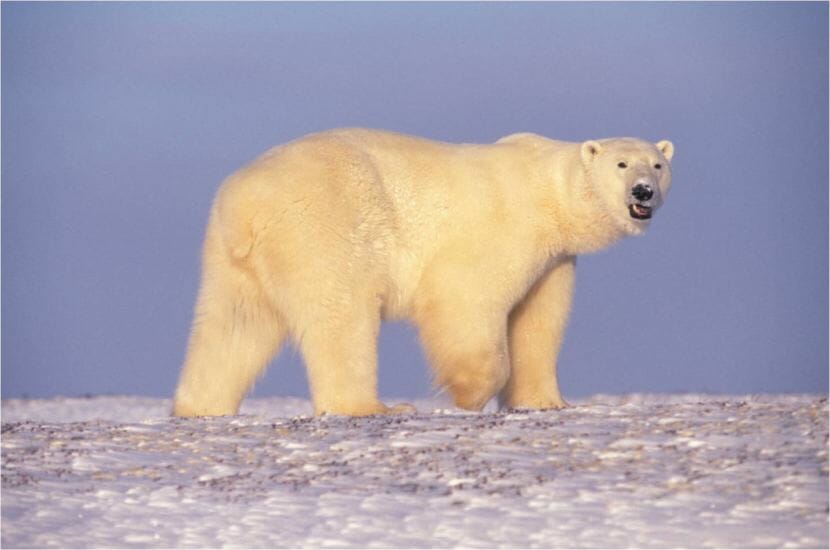
Last year, a company asked the Trump administration for permission to take the first steps toward oil drilling in the Arctic National Wildlife Refuge: running a convoy of special oil-detecting trucks along the refuge’s coastal plain, to determine how much petroleum lies below.
But the Trump administration never gave the go-ahead, with the U.S. Fish and Wildlife Service saying that the initial proposal didn’t comply with federal rules under the Marine Mammal Protection Act. That rule limits harm to polar bears, which are listed as threatened under the Endangered Species Act. A government shutdown also delayed work on the application from the company, Houston-based SAExploration, which has never said publicly exactly why the project did not move ahead.
Now, a newly-published study by the Fish and Wildlife Service and the U.S. Geological Survey shows what kinds of precautions companies could take to obtain federal approval to explore for oil in sensitive polar bear habitat. By using heat-sensing cameras to detect dens, and accepting strict limits on when to survey specific areas of the coastal plain, the study says that polar bear disturbance can be dramatically reduced – from as many as eight dens if no restrictions are applied, to one or less using the most conservative approach.
“A carefully-designed survey can reduce your potential impacts to the bears pretty far – to the point where you might be getting to a place where you may be able to meet determinations under the Marine Mammal Protection Act,” said Ryan Wilson, a Fish and Wildlife Service polar bear biologist and one of the two authors of the study, published in the Journal of Wildlife Management.
The study offers a window into the push and pull between the competing stakeholders and statutes that are shaping the future of the Arctic Refuge – the top Trump administration appointees and oil industry pushing to access the coastal plain after Congress passed a law opening the area to drilling in 2017, the environmental organizations fighting them and the Fish and Wildlife Service employees charged with enforcing the Marine Mammal Protection Act, which was enacted in 1972.
Wilson once worked for an environmental organization, The Wilderness Society, and he said in an interview that the study was not influenced by Trump administration political appointees, who have pushed to expand oil development across Alaska’s North Slope.

The study’s findings offer a basic blueprint for how the oil industry might move forward with what’s known as a seismic survey across the coastal plain. But, they do not equate to authorization or approval for a specific project.
An Anchorage-based official with one environmental group, Defenders of Wildlife, noted that such a survey is only an initial phase of oil development. If the results are promising, companies would move ahead with test wells and then permanent infrastructure, which would bring additional impacts. And even with the precautions suggested by the study, the survey’s risk of disturbing polar bears would not be reduced to zero, said Defenders of Wildlife’s senior Alaska representative Pat Lavin.
“Even with extensive restrictions and making favorable assumptions about the impacts that would follow, the risk of injury or death to polar bears cannot be eliminated,” Lavin said. “And that’s without building anything.”
The study grew out of the 2018 proposal from SAExploration, which specializes in seismic surveys. The company, working with three Alaska-based Native corporations, wanted to run its survey across the entire coastal plain, with its dozen trucks running along grid lines spaced 200 meters apart.
The effort would have run 24 hours a day, supported by dozens of additional vehicles and at least one camp that would accommodate 150 people.
Those plans were complicated by the Southern Beaufort Sea population of polar bears, which number about 900 and are vulnerable to declining sea ice caused by global warming.
The Marine Mammal Protection Act bars disturbances to polar bears and other species, but it allows the Fish and Wildlife Service to authorize occasional incidental impacts, including in cases where development has a “negligible impact” on a population. One metric commonly used by the federal government is known as “potential biological removal,” and using that measure, Alaska Natives’ annual subsistence harvest – which has a higher priority under the act – already exceeds that level for the Southern Beaufort Sea bears. And that means that the Fish and Wildlife Service has little wiggle room to authorize accidental impacts on the bears from oil exploration.
That dynamic creates complications for companies like SAExploration.
The oil industry does its exploration work during the winter, when its vehicles won’t damage the Arctic tundra – and that’s the same season in which polar bears den. Disturbances can make it less likely for cubs to survive, since they can be exposed to the Arctic winter if they leave their dens, or use more energy if they stay.
The new study assumes that just 20 dens will be scattered across the entire coastal plain in a given winter. But the Fish and Wildlife Service assumes that industry activity within a mile could cause a disturbance, creating potential conflicts for every den, given SAExploration’s proposal to run its trucks along grid lines separated by just 200 meters.
Wilson was working with the Fish and Wildlife Service to analyze SAExploration’s initial survey plans, and determined its impacts would likely be too big to comply with the Marine Mammal Protection Act’s restrictions, he said. But through discussions with company officials, he added, they developed a revised plan, in which earlier in the winter, when cubs would be more likely to remain inside their dens, SAExploration would avoid areas with denser dens.
To help assess the impacts of the different plans, Wilson created a computer model, which is the basis for the newly-published study, co-authored by George Durner, an Anchorage-based zoologist for the USGS.
The study looked at five different types of proposed surveys, with different timing and area limitations like the ones contemplated by Wilson and SAExploration, and it used the computer model to run 1,000 different simulations of each one. It also assessed how the use of the heat-sensing cameras, to detect heat rising from polar bear dens, could help reduce impacts.

Without the heat-sensing cameras or any restrictions on the time and space of the survey, the study predicted that industry activity would cross the one-mile threshold of roughly eight dens before the bears had emerged – though that number fell to roughly 2.5 dens if companies used the heat-sensing technology.
The most restrictive plan, by contrast, divided the survey area in 28 different blocks, then set specific dates when the work could begin for each one, leaving the most important denning areas until later in the winter. It also split the survey into two years, allowing the work to start later in the winter and reducing the likelihood of encountering a den with bears still in it.
The study predicted that with those limitations, the survey would impact, on average, 0.5 dens – and using the heat-sensing technology reduces that to 0.2.
Wilson reiterated that those findings do not necessarily mean that a proposal incorporating those timing and area restrictions will necessarily be approved by the Fish and Wildlife Service.
“It’s not making judgment calls or anything,” he said. “It’s trying to help inform decision-makers, applicants and the general public about what we need to be considering if if we really are going to try to find this balance between development and conservation of polar bears.”
One big question that the study leaves unanswered is whether agreeing to the timing and area limits would make the seismic survey too expensive, or logistically complex, for the oil industry to undertake. SAExploration officials declined to comment, and Kara Moriarty, the head of the Alaska Oil and Gas Association, said she did not want to speculate.
Moriarty’s group, which advocates on the oil industry’s behalf, supports using the “best available science” to minimize impacts on wildlife, she said.
But she also argued that the study gives a kind of “worst-case scenario” look at development – and that companies would likely take precautions to reduce risks below the levels the study assumes.
“We do have really good management techniques at play now, and that are effective at identifying, mitigating, minimizing any type of impact to the bear,” she said. “Because that’s the last thing we want.”
There’s no seismic work planned inside the refuge this winter. But it’s likely that new surveys will be proposed after the federal government holds its first lease sale for the coastal plain, which is expected some time in 2020.
